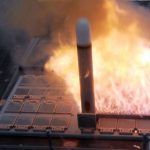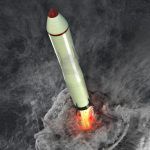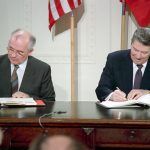Save the INF Treaty—but not by repeating history
By Thomas Graham, Jr., Bernadette Stadler | September 13, 2017

In 1983, the United States began deploying ground-based intermediate-range nuclear missiles in Europe. The deployment caused the Soviets to walk out of ongoing arms control negotiations. But it also led to the negotiation of the Intermediate-Range Nuclear Forces (INF) Treaty and the elimination of an entire class of missiles from the arsenals of the United States and the Soviet Union.
Thirty-odd years later, as the United States contends with a Russian violation of the INF treaty, some experts and policy makers have urged Washington to develop its own treaty-violating missile and to help allies—who are not bound by the treaty—acquire the new missile. Indeed, Congress is currently considering legislation calling for the United States to develop a program of record for a missile that, if tested, would violate the treaty. But even if the United States retraced all the steps it took during the initial INF Treaty negotiations—including the deployment of intermediate-range missiles in Europe—it could not recreate the underlying conditions that allowed the negotiations to succeed in the first place. Only a clear understanding of today’s underlying conditions can shape an effective response to Moscow’s treaty violation.
How it happened. In the late 1970s, the Soviet Union deployed in Europe an accurate, road-mobile, intermediate-range ballistic missile equipped with multiple independently targetable warheads. The missile, known as the SS-20, sparked concern within NATO. The SS-20 system appeared to be a nuclear war–fighting weapon, as opposed to a weapon of deterrence, and was regarded as a huge threat to the alliance.
In 1979, NATO responded with a “double-track” strategy, which entailed engaging the Soviet Union in negotiations on theater nuclear forces while simultaneously preparing to deploy US intermediate-range missiles in Europe if negotiations failed. Though the US missiles that were eventually deployed are often perceived solely as a response to the deployment of the SS-20, they were also intended to reassure NATO allies concerned that arms control treaties, including a new Strategic Arms Limitation Treaty (SALT II), would weaken US extended deterrence.
The US-Soviet negotiations that ultimately resulted in the INF Treaty began in 1980, but neither side seemed to take the talks particularly seriously. Rather, NATO’s European members were the driving force behind the negotiations. Though they never had a seat at the bargaining table, European NATO members knew they faced an uphill battle in persuading their citizens to accept US missiles if diplomacy failed—and therefore they wished to see it succeed. The United States had less skin in the game and might have let the negotiations languish without NATO pressure. On the Soviet side, General Secretary Leonid Brezhnev was not willing to accept limitations on his nation’s very large force of intermediate-range missiles. And the Soviets were optimistic that public opposition to US missiles in Europe might prevent their deployment.
In 1981, Ronald Reagan inherited the INF negotiations and announced an ambitious new vision for the talks: the “zero option,” under which the United States would deploy no intermediate-range missiles in Europe if the Soviet Union eliminated its own intermediate-range missiles. Brezhnev rejected this proposal as one-sided because it would require the Soviet Union to dismantle existing weapons while the United States would only have to forgo deploying new ones. In 1983, with no progress achieved on the diplomatic track, the United States began deploying Tomahawk cruise missiles and Pershing II ballistic missiles in Europe. In response, the Soviets walked out of the negotiations—which only resumed in early 1985.
Shortly after the negotiations restarted, Mikhail Gorbachev came to power. In contrast to his predecessors, who attempted to achieve foreign policy objectives by increasing Soviet military might, Gorbachev believed that security could be based on political measures, including arms control. Under Gorbachev, the Soviet military’s influence over foreign policy weakened, and the Politburo even re-evaluated the SS-20 and concluded that it was militarily irrelevant. Under Gorbachev, the INF negotiations gained pace.
In 1986, Reagan and Gorbachev met in Reykjavik to discuss arms control. The leaders made remarkable progress—almost finalizing an agreement that would have, in principle, eliminated all nuclear weapons. Though they were unable to achieve this lofty goal, they built momentum for the INF talks, which concluded with the signing of the treaty in December 1987.
What’s different now. The INF Treaty was the product of a specific moment in history, and its successful negotiation depended on a number of conditions that do not pertain today. First, NATO countries played an important role in influencing US actions during the negotiations. Members of the alliance, West Germany in particular, pushed the United States to deploy missiles in Europe to solidify US extended deterrence and counter the Soviet threat. European leaders pushed for deployment even though they faced enormous pressure from politicians at home who opposed the introduction of missiles into Europe, as well as from the public, which was deeply antinuclear.
Today, NATO countries seem ambivalent about Russia’s INF violation. The United States, in order to protect sources and methods, has thus far been unable to share with its NATO allies in-depth information about the violation. Some allies have been reluctant to confront Russia until they see more evidence.
Even if they possessed all the information, members of the alliance would be reluctant to accept new nuclear weapons systems on their territory. Five NATO states—Belgium, the Netherlands, Germany, Norway, and Luxembourg—have previously called for the United States to remove from Europe its approximately 150 to 200 tactical nuclear weapons. Some observers have speculated that NATO’s newest members might accept US missiles on their territory, but since NATO decisions are made by consensus, the whole alliance would have to support the decision to deploy missiles.
Furthermore, negotiations toward the INF Treaty succeeded in part because of the personal characteristics of Soviet and US leaders at the time. Unlike his predecessors, Gorbachev favored an improved relationship with the West and believed that arms control negotiations could contribute to Soviet security. Gorbachev and Reagan also seemed to hold nuclear weapons in a different regard than did other Cold Warriors. Reagan famously pronounced that “[A] nuclear war cannot be won and must never be fought.” Gorbachev called for the “complete elimination of nuclear weapons.” Although some dismiss these stances as political posturing, the attempts by Reagan and Gorbachev to rid the world of nuclear weapons at Reykjavik demonstrated their commitment to disarmament.
US and Russian leaders today are substantially different from Reagan and Gorbachev. President Donald Trump has professed to want better relations with Russia, but he has also been the subject of intensive investigation into potential collusion with Russia during his presidential campaign. His independence in dealing with Russia has been further stymied by anti-Russia sentiment in Congress, which recently passed sanctions against Moscow. While President Vladimir Putin appears to have a positive personal relationship with Trump, he thrives on competition with the United States and may count on it for political survival. Furthermore, neither Trump nor Putin has expressed any particular affinity for arms control.
What to do. Conditions have changed since the INF Treaty was negotiated, but saving the treaty and preventing a new SS-20–like threat to Europe are not impossible. The United States, in order to bring Russia back into compliance, will have to adopt strategies that are specifically tailored to the conditions that exist today—conditions that include possible NATO reluctance to host new nuclear-capable weapons systems and Putin’s aggressive approach to foreign affairs.
One possible approach involves capitalizing on Russia’s refusal to admit that it is in violation of the treaty, despite its having been presented with evidence of the infraction—and Moscow’s preference, if the treaty is indeed to fail, that blame land on the United States. Unfortunately, that is precisely where blame would land if Washington were to develop an intermediate-range missile system that, if tested and deployed, would violate the treaty. If, on the other hand, the United States shared with its allies indisputable evidence of Russia’s violation, pressure on Moscow to come back into compliance would mount. In addition to publicizing Russia’s violation, the United States should also offer Russia a way to save face and return to compliance without having to admit a violation.
If the time ever comes for the United States to remind Russia just how much it hated the deployment of US missiles in Europe, it could do so without violating the INF Treaty. Steven Pifer, a non-resident senior fellow at the Brookings Institution, has suggested that the United States could deploy additional conventional air- and sea-launched cruise missiles to Europe. These systems exhibit several advantages: They would not violate the INF Treaty, which only covers ground-based systems; they are already in the US arsenal; and they would be easy to remove if Russia returned to compliance.
The original negotiations toward the INF Treaty offer valuable lessons about handling Russia’s violation of the agreement—but simply matching Russia’s violation with a new violation is not a viable solution. Negotiations succeed and fail for a number of complex reasons, including who is in power, who is at the table, and how the international community views (and whether it supports) the negotiations. To save the INF Treaty, the United States must develop strategies that both acknowledge—and take advantage of—circumstances that exist today.
Together, we make the world safer.
The Bulletin elevates expert voices above the noise. But as an independent nonprofit organization, our operations depend on the support of readers like you. Help us continue to deliver quality journalism that holds leaders accountable. Your support of our work at any level is important. In return, we promise our coverage will be understandable, influential, vigilant, solution-oriented, and fair-minded. Together we can make a difference.
Share: [addthis tool="addthis_inline_share_toolbox"]















